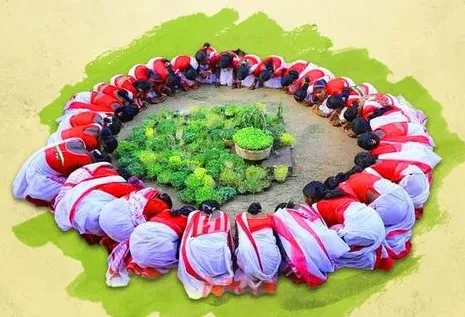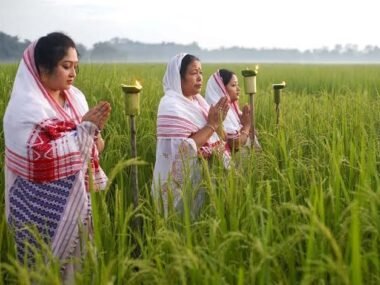Introduction to Karam Puja
Karam Puja is a vibrant and significant festival celebrated by various tribal communities in India, particularly in the states of Jharkhand, Odisha, Assam, Chhattisgarh, Bihar, and West Bengal. This festival is deeply rooted in agricultural traditions and pays homage to Karam Devta, the deity of youth, strength, and fertility. Karam Puja symbolizes the reverence of nature, prosperity, and the hard work of farmers, making it one of the most cherished celebrations among tribal societies.

Historical and Cultural Significance
Karam Puja has been observed for centuries, with its origins tracing back to the agrarian lifestyle of indigenous communities. It marks the significance of trees, nature, and agricultural cycles, which are crucial to the livelihood of these communities. Unlike mainstream Hindu festivals that often revolve around temple rituals, Karam Puja is predominantly a folk tradition, conducted in open spaces, forests, or near water bodies.
The festival represents the bond between humans and nature, emphasizing the importance of ecological balance and sustainable farming. It is also seen as a time to invoke divine blessings for a bountiful harvest and protection from natural calamities.
When is Karam Puja Celebrated?
Karam Puja usually falls in the Hindu Bhadrapada month (August–September), on the eleventh lunar day (Ekadashi) of the bright fortnight. However, the exact date may vary slightly among different communities. The timing of the festival aligns with the completion of sowing activities and the beginning of the growing season, making it an occasion to pray for fertility and prosperity.
Rituals and Celebrations
1. The Sacred Karam Tree Ritual
The core ritual of Karam Puja revolves around the Karam tree (Nauclea Parvifolia), which is considered sacred. A young unmarried girl or group of women, referred to as ‘Karam Nachni’, leads the main ritual. The process includes:
- Fetching the Karam Branch: The selected girl or group ventures into the forest to cut a branch of the Karam tree, singing traditional songs and following strict rituals.
- Placing the Branch: The Karam branch is then planted in the center of the ceremonial ground, decorated with flowers and offerings.
- Worship and Songs: Devotees offer grains, fruits, and liquor to Karam Devta, accompanied by traditional folk songs and dances.
- Night Vigil: The night is spent in continuous singing, drumming, and storytelling, narrating myths related to Karam Devta and agricultural prosperity.
2. Fasting and Devotion
Many participants observe a fast (Upvaas) throughout the day until the rituals are completed. It is believed that the fast enhances spiritual energy and devotion, allowing individuals to connect with nature and the divine.
3. Dance and Music: The Heart of Karam Puja
The festival is incomplete without traditional dance forms such as the Jhumair, Domkach, and Chhau, performed in groups. The rhythmic beats of the Madal (drum) and melodious tribal songs create an atmosphere of joy and unity. Dance and music are integral to Karam Puja, as they represent the celebratory spirit and communal harmony.
4. Karam Mythology and Storytelling
A unique feature of Karam Puja is the oral storytelling tradition, where elders narrate the legend of Karam Devta. The story highlights the importance of respecting nature, working hard, and maintaining social harmony.
Importance of Karam Puja in Modern Times
In today’s world, where environmental degradation and unsustainable agricultural practices threaten nature, Karam Puja serves as a reminder of eco-conscious living. It teaches us about the delicate relationship between humans and the environment and promotes the conservation of forests and biodiversity.
Additionally, Karam Puja is a cultural identity for indigenous communities. It strengthens social bonds, preserves age-old traditions, and fosters a sense of belonging. Governments and cultural organizations have started recognizing the festival’s significance, supporting efforts to document and promote its traditions.
Regional Variations of Karam Puja
Although the essence of Karam Puja remains the same, different regions celebrate it with slight variations:
- Jharkhand and Chhattisgarh: The festival is grandly celebrated with large processions, community feasts, and tribal fairs.
- West Bengal and Odisha: Here, Karam Puja is linked to folk dramas and performances.
- Assam: The tribal communities of Assam celebrate it with elaborate dance performances and storytelling sessions.
Conclusion: A Celebration of Culture and Nature
Karam Puja is more than just a festival—it is a reflection of an age-old way of life where nature is worshipped as a divine entity. It underscores the importance of sustainable living, community bonding, and cultural heritage. As modern society moves toward rapid industrialization, the message of Karam Puja remains ever-relevant: respect nature, honor traditions, and celebrate life in harmony with the environment.
By keeping this tradition alive, we not only preserve our rich cultural heritage but also contribute to a future where nature and humanity coexist in balance and prosperity.
FAQ’s
Q. What is the significance of Karam Puja?
Karam Puja is an important festival among tribal communities, celebrating Karam Devta, the deity of youth, strength, and fertility. It symbolizes agricultural prosperity, nature worship, and social harmony.
Q. When is Karam Puja celebrated?
Karam Puja is observed during the Bhadrapada month (August–September), typically on the 11th day of the bright fortnight (Ekadashi), depending on the lunar calendar.
Q. Which states in India celebrate Karam Puja?
Karam Puja is mainly celebrated in Jharkhand, Odisha, Assam, Chhattisgarh, Bihar, and West Bengal, with variations in rituals and traditions.
Q. Why is the Karam tree important in Karam Puja?
The Karam tree (Nauclea Parvifolia) is considered sacred as it represents fertility, strength, and prosperity. Its branch is worshipped as a symbol of divine blessings for a good harvest.
Q. What is the mythological story behind Karam Puja?
According to folklore, Karam Devta blessed farmers with prosperity but punished those who neglected their responsibilities. The festival reminds people of the importance of hard work, respect for nature, and community unity.












